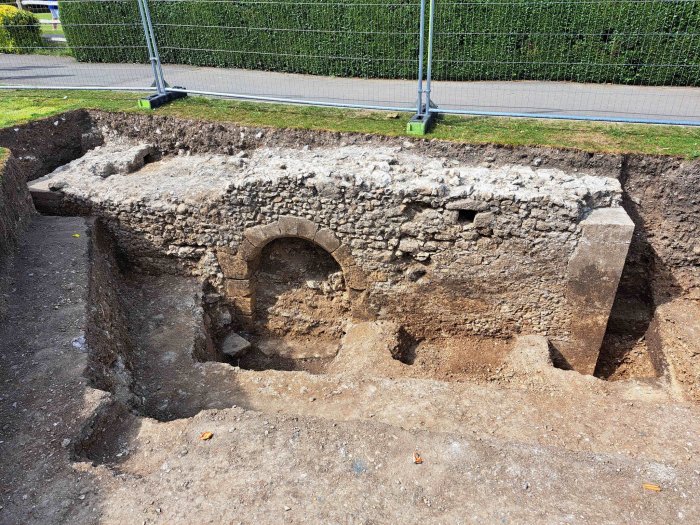Conny Waters – AncientPages.com – During archaeological excavations in Chichester’s Priory Park, archaeologists unearthed remains of a Norman-era defensive tower that defended Chichester’s Castle.
Shortly after the Norman Conquest (11th-century invasion and occupation of England), Roger de Montgomery (also known as Roger the Great) ordered the construction of a castle at Chichester. The castle was one of 11 fortified sites to be established in Sussex before 1100.
Image credit: Chichester & District Archaeology Society
During the recent two-week excavation, led by Chichester District Council’s archaeologist James Kenny in partnership with the Chichester and District Archaeological Society (CDAS), the remains of a tower were uncovered. This marks the eighth excavation in this series, concentrating on an area north of The Guildhall.
According to geophysicists’ work and ground-penetrating radar scans, the excavations at the site were conducted since 2022, providing valuable insights into the site’s historical significance.
In 2024, the team discovered the remains of a masonry causeway and bridge that would have connected to the motte and bailey castle. They also uncovered part of a ditch that encircled it. The objectives for this year included locating the inner edge of the ditch and excavating further to determine its depth and reach the base of the masonry foundations.
“Until we uncovered the stonework, it was believed that the castle was purely a timber structure, but the discovery of a robust masonry causeway — and now tower — means that the castle was rebuilt in stone, something that could only have been sanctioned by someone in authority,” says James Kenny, Archaeology Officer at Chichester District Council.
“This is hugely exciting because it places this castle and the importance of this area in a different light to what we previously thought.”
This significant structure extends 1.7 meters from its foundation to just below ground level and measures approximately 6 meters by 10 meters in plan.
The excavation at Priory Park, Chichester. In 2024, the team discovered the remains of a masonry causeway and bridge that would have connected to the motte and bailey castle. Image credit: Chichester District Council
The next step for the researchers is to determine who commissioned the construction, suggesting it was someone with considerable authority. The most probable figures and both of significant authority are the Earl of Arundel from the mid-12th century or, if it was built at a later date, King Henry II, who ruled from 1154 to 1189.
The castle was constructed to strengthen the authority of the feudal lord during that era, and designed to impress. At the same time, the goal was to assert dominance through the use of superior architecture and the finest stonemasons.
And as James Kenny said, “the castle was built to reinforce the power of the feudal lord of the time and would have been built to impress and dominate using the finest architecture and best stonemasons of the time. It’s been a very exciting conclusion — these sorts of archaeological discoveries do not happen often in a lifetime, and it’s certainly the finest piece of medieval architecture that I’ve ever excavated.”
During the excavation, the team also uncovered remnants of the Medieval Franciscan friary that once occupied the site. Among these findings were examples of its intricately decorated floor tiles, providing valuable insights into the historical and architectural significance of the friary.
Image source
The date of the Franciscans’ first arrival in Chichester is not known. Still, it may have been soon after they arrived in England in 1225, as Brother Walter de Colevile, one of the first friars to come to this country, had connections in Chichester. They had undoubtedly been settled some little time earlier, before 1253 when Henry III confirmed the grant made in their favour by his brother Richard, earl of Cornwall, of a lane adjoining their premises.
There is so much history in Chichester, a small Roman and Anglo-Saxon settlement and a major market town from those times through Norman and medieval times to the present day.
Therefore, this discovery is no doubt, a significant achievement in archaeology, as such findings are rare. It stands out as an exceptional example of medieval architecture, representing one of the finest pieces ever excavated by experts in the field.
All findings from the excavation will be meticulously documented, and some of the remains permanently to the public.
This initiative would be part of a distinct project and would require securing external funding. According to Councillor Bill Brisbane, Cabinet Member for Planning at Chichester District Council, these excavations consistently reveal valuable insights into our local history, with this year’s discovery being no exception. The unearthing of a barbican is particularly significant as it alters our previous understanding of the castle’s structure and history.
See also: More Archaeology News
“It’s also fantastic that residents and visitors have been able to watch and see this local archaeology in action and witness the painstaking work that goes into understanding more about our past. I’d like to thank all the volunteers that have helped with these digs over the years — I know the team have received some very positive feedback following this year’s work,” Bill Brisbane said.
Written by Conny Waters – AncientPages.com Staff Writer




